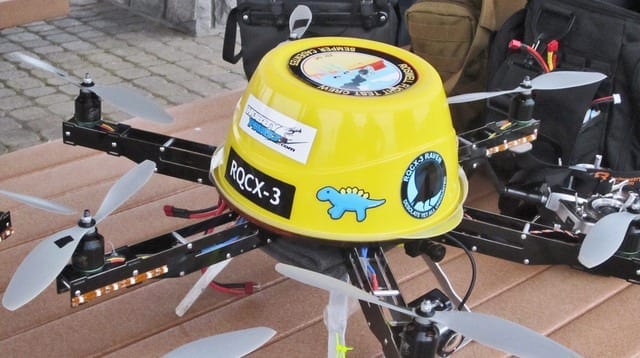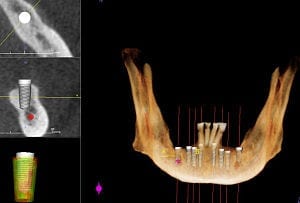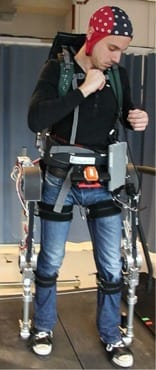
The ways we report and consume news have changed radically in recent years.
Now not only are journalism schools adapting to answer the challenges of producing content on all shapes and sizes of screens and devices while maintaining integrity–with fewer resources than ever–two college journalism programs are also teaching students how to operate drone aircraft for story-gathering and reporting. Both classes are considered experimental. But they’re also easily replicated at any university. (Drones are getting pretty cheap, too.)
The University of Nebraska-Lincoln’s Drone Journalism Lab and the Missouri Drone Journalism Program at the University of Missouri are the first two programs of their type in the nation. At both universities, journalism students are taught the basics of flying unmanned autonomous vehicles (UAVs), using still and video cameras to gather aerial information, the ethics of operating flying cameras, FAA regulations and safety, and how to interpret aerial footage. The goal is to turn information gathered from the air into workable stories.
Both programs are experimental, but operate in different ways. The Nebraska Lab is integrated into the university’s college of Journalism and Mass Communications, and serves as a stand-alone proof-of-concept learning lab. “In short, drones are an ideal platform for journalism,” according to the lab’s mission statement online.
However, the Missouri Program is a partnership between the university’s Journalism School, Information Technology program, and a local NPR affiliate,KBIA. While Nebraska’s project has been going on since late 2011, Missouri’s drone journalism effort just launched in February 2013. The NPR affiliate secured a $25,000 grant for the university to build custom drones.
One story published by the University of Nebraska program used drones to document an ongoing drought. The University’s drone lab, NIMBUS, provided several UAVs to the journalists to explore the story. “We turned all flight operations over to Carrick Detweiler, a professor of computer science at UNL and cofounder of the NIMBUS Lab. He flew the lab’s Ascending Technologies Falcon 8 UAV, a $25,000 aircraft with eight rotors and a gimbal-mounted camera on the front. Detweiler had experience with the vehicle and with flying it,” said Matthew Waite of the Drone Journalism Lab.
“We talked about what we wanted to see from the air before going up and we left Detweiler to fly the UAV. That’s an important point. The pilot of the UAV is responsible for the safety of the vehicle and anyone around it. So the pilot needs to be left alone to fly, not take over-here-now-over-here directions from a journalist. During battery changes, we talked briefly about what we were getting, and that was it.”
Once footage was compiled, the finished video was used to portray a record-breaking drought in their home state of Nebraska. The journalists also experimented with a homemade tool: a scientific data-gathering UAV. Another UAV, the Ascending Technologies Hummingbird, was equipped with an improvised rig of dowels, electrical tape, and a glass ampule to acquire a water sample. The drone successfully acquired testable water samples from the Platte River.
The Latest Bing News on:
Drones Go To Journalism School
- Drones give Harmar elementary students glimpse at future job skillson May 8, 2024 at 6:35 am
Rikki Haas and Elizabeth Pribanic were at school Tuesday but had their eyes in the skies. The duo — as calm and as focused as could be — were operating drones outside the gymnasium of Acmetonia ...
- Students in Decatur and Athens schools learning drone technologyon May 8, 2024 at 5:44 am
Students often complain that their teachers drone on and on, but that's not an issue for local third graders who are learning math and programming skills by operating drones. Stevi Price, executive ...
- Hayward’s drone soccer team students display skills to governor, former OSU standouton May 7, 2024 at 2:57 pm
Hayward Middle School’s drone soccer team members showed off their skills to Ohio Gov. Mike DeWine and Ohio State Buckeye football standout and Springfield native Braxton Miller on Tuesday afternoon ...
- It’s a new frontier for Westlake High School students learning to fly droneson May 6, 2024 at 5:00 am
Students participating in Westlake High School's Unmanned Aircraft Systems (UAS) Drone Technology class will be able to operate drones as part of their curriculum, thanks to approval from the Federal ...
- High school students participate in drone competitionon May 4, 2024 at 3:18 pm
WHERE THE ZEBRAS WERE ORIGINALLY HEADED. NOW TEACHING HIGH SCHOOL STUDENTS ABOUT TECHNOLOGY AND ETHICS WHILE FLYING DRONES. THAT’S THE PURPOSE OF TODAY’S DRONE COMPETITION IN MANCHESTER.
- Drone And Aviation Event Allows Green Country High Schools To Learn About STEM, Engineeringon May 3, 2024 at 6:08 pm
The event at the TCC Riverside Campus allowed students to learn about the expanding use of drones and the demand for drone-related careers.
- Drone And Aviation Event Allows Green Country High Schools To Learn About STEM, Engineeringon May 3, 2024 at 11:27 am
The Siegfried Drone and Aviation Showcase, sponsored by the Tulsa Regional Stem Alliance, had 170 high school students participate on Friday. The event at the TCC Riverside Campus allowed students ...
- Russian high schools to begin training children in the use of droneson April 29, 2024 at 9:57 am
The new subject is called “Fundamentals of Security and Homeland Defense” and joins others with which the Kremlin has militarized educational centers ...
- Students go head to head in drone flying competition at Krammer Middle Schoolon April 27, 2024 at 8:50 pm
FOR THE WOMEN TO CHOOSE FROM. DOZENS OF JCPS STUDENTS REACHED NEW HEIGHTS THIS MORNING. STUDENTS FROM FIVE JCPS SCHOOLS CHECK IT OUT. THEY LEARNED HOW TO FLY DRONES AND THEN PARTICIPATED IN A DRONE ...
- Emmanuel Christian’s drone, aviation program grows to include 5 Ohio schoolson April 25, 2024 at 5:00 pm
The dual drone and aviation program at Emmanuel Christian Academy has “grown significantly” over the last six years since it started and is now in five Ohio schools ... get to go out and ...
The Latest Google Headlines on:
Drones Go To Journalism School
[google_news title=”” keyword=”Drones Go To Journalism School” num_posts=”10″ blurb_length=”0″ show_thumb=”left”] [/vc_column_text]The Latest Bing News on:
Drones for journalism
- Air Force: Ukraine downs 17 Russian droneson May 8, 2024 at 9:32 pm
Ukrainian air defense units destroyed 17 of 20 Shahed-type drones that Russia launched overnight, the Air Force reported on May 9.
- BharatRohan Raises 2.3 Million USD in Funding, Strengthening its Leadership in Drone Driven Agricultural Innovationson May 8, 2024 at 9:46 am
BharatRohan secures USD 2.3 million in pre-IPO funding to further develop and expand its innovative CropAssure® system benefiting farmers across India.
- Ukraine reaches parity with Russia on production of deep strike drones, says arms makeron May 8, 2024 at 7:16 am
Ukraine said on Wednesday it was producing the same number of deep strike drones as Russia, claiming to have reached parity on a key type of weapon that Moscow has used for long-range ...
- Ukrainian Defense Forces Intercept Dozens of Missiles and Droneson May 8, 2024 at 12:00 am
Be a part of the support network for independent Ukrainian journalism. Your contribution matters. Join as a member Provide one-time support In a significant defensive operation through the night of ...
- Hayward’s drone soccer team students display skills to governor, former OSU standouton May 7, 2024 at 2:57 pm
Hayward Middle School’s drone soccer team members showed off their skills to Ohio Gov. Mike DeWine and Ohio State Buckeye football standout and Springfield native Braxton Miller on Tuesday afternoon ...
- Establishment of a New Military Branch for Unmanned Systems Approved by Governmenton May 7, 2024 at 9:45 am
Support independent journalism in Ukraine. Join us in this fight. Become a member Support us just once On May 7, the government gave its support to a presidential draft decree for establishing an ...
- Drones above, police at the gates: Columbia protest camp's final momentson May 4, 2024 at 10:08 am
Hours after negotiations between administrators and student leaders failed, police arrested dozens of people and cleared out protest encampments that spawned similar demonstrations at colleges around ...
- Drone footage leads to remains of woman missing since June of 2023on May 2, 2024 at 9:42 am
The family of a 27-year-old Boise woman who was last seen in Jordan Valley in June of 2023 is expressing thanks to those who helped to find ...
- Okinawa's Ishigaki uses drone for first time during marine survey around Senkakuson April 29, 2024 at 1:23 am
During the survey, China Coast Guard vessels entered Japanese waters around the islands and attempted to interfere with the city's ship.
- Army officials question plan for future attack reconnaissanceon April 26, 2024 at 11:58 am
The service did away with the pursuit of a new manned armed scout helicopter and is grappling with how to fill the gap using a network of smart drones.
The Latest Google Headlines on:
Drones for journalism
[google_news title=”” keyword=”drones for journalism” num_posts=”10″ blurb_length=”0″ show_thumb=”left”]










